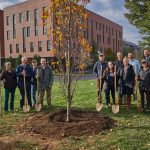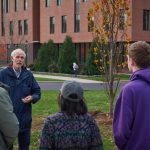Trees are an everyday part of campus life at UConn. They help measure the passing of time from fall to winter to spring, provide the campus with shade and places of reflection, and add to the health of the environment.
For many of those who pass them by each day, the trees go unnoticed. For the UConn Arboretum Committee, the trees are sights of majestic glory that make the campus the beautiful environment that it is.
The newest project by this committee, made up of university faculty, staff, and students, is the concept of class trees. The hope is that each graduating class will support the arboretum endowment fund and identify a tree tribute for their year.
This effort kicked off on Tuesday, Oct. 23, as a fastigiate tulip tree was planted along Fairfield Way near Hall Dorm. The fastigiate tulip, a member of the Magnolia family, has an upright form, with large, bright green, smooth lobed leaves that appear in the spring time, turning to golden yellow in the fall. Its late spring flowers attract hummingbirds, and the seeds are eaten by both birds and small mammals.
We would like the current students to take ownership of this and have each class plant trees. It brings people back to campus after they graduate. They can show their children and grandchildren. — Greg Anderson
The class tree initiative is led by emeritus professors Greg Anderson, Distinguished Professor of Ecology and Evolutionary Biology, and Richard Brown, Distinguished Professor of History. Both are members of the committee, with Anderson serving as one of its co-chairs.
“There are actually class trees all over campus from the 1950s and 1960s that are now very mature,” says Anderson. “We would like the current students to take ownership of this and have each class plant trees. It brings people back to campus after they graduate. They can show their children and grandchildren that this is a tree their parent or grandparent planted.”
Anderson and Brown are both students of the history of trees and the overall landscaping of the UConn campus. They recount that it was President Charles Beach (serving from 1908 to 1928) who developed the concept of the Great Lawn, which still lies adjacent Route 195 today and provides a majestic view of campus.
“It was not simple,” says Anderson. “The land that makes up the Great Lawn was not all owned by UConn, and President Beach had to acquire parcels of land from different groups to make it work.”
The current UConn administration, under President Susan Herbst, has been very supportive of the work of the Arboretum Committee and the overall landscaping of the campus, according to Anderson and Brown.
“It has been a very positive and very collaborative effort,” says Brown. “One of the great glories of this university is its plantings. We have the philosophy that, if possible, trees should be repaired, instead of taken down.”
The committee works closely with UConn’s Landscape Services, which is part of Facilities and Operations, and University Planning, Design, and Construction. Sean Vasington, associate director of University Planning, Design, and Construction, and university tree warden Eileen McHugh are among the University staff that serve on the committee.
Both Anderson and Brown have a life-long love of the outdoors, plants, and specifically, trees.
“I always loved being outside and always loved plants,” says Anderson, who grew up in Minnesota and came to UConn as a faculty member in ecology and evolutionary biology in 1973. He currently does research on pollination on remote islands, including some off the coast of Chile that inspired the classic, Robinson Crusoe.
Brown, a New Milford, Connecticut, native, who joined the history faculty in 1971, has also always loved trees and their physical beauty.
“Their hard wood and immortality has always fascinated me,” says Brown. “You look at a tree and realize it was there before you were born and that it will be there after you are gone.”
UConn is recognized as a Tree Campus USA by the Arbor Day Foundation – the only school in the state of Connecticut and one of just three in New England to have that distinction.
The class tree project will be managed as part of the Campus Beautification Fund at the UConn Foundation. To make a donation to the fund, please visit https://uconn.networkforgood.com/causes/13163-campus-beautification-fund.






